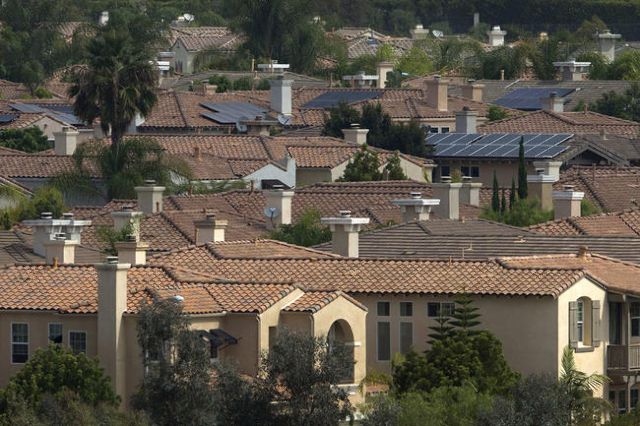California narrowly upholds key policy for solar growth

California has delivered a narrow victory to the solar industry by maintaining a policy that has underpinned rooftop solar’s dramatic growth while introducing fees that were smaller than utilities requested.
After two years of rancorous debate, California’s Public Utilities Commission upheld net metering by a vote of 3-to-2 on Thursday, allowing homeowners with solar panels to keep selling the excess power they generate back to their utility at the full retail rate.
Homeowners with solar panels cheer net metering as it lowers their power bills. But net metering has been criticized by utilities and some ratepayer advocates for rewarding solar users while leaving others to shoulder the cost of maintaining the electricity grid.
The decision was being watched far beyond the Golden State by states and utilities that are working to integrate ever larger amounts of rooftop solar onto their power grids.
Most states have passed laws allowing net metering, but a 40 percent drop in the cost of residential solar installations in the last five years has prompted some to review those policies amid calls by utilities to roll them back. Most recently in Nevada, regulators last month approved changes to the state’s net metering policy that prompted some solar companies to stop doing business there.
The narrow victory in California reflected what the Commission said was the difficult job of balancing its desire to support the growth of rooftop solar while making sure solar customers pay their fair share.
“I will be the first to say that I think we really have a ways to go before we have a really enduring rooftop strategy,” said PUC President Michael Picker, who voted in favor of extending the policy.
In response to critics, the PUC did make some changes that will drive up the cost of going solar.
Solar customers will have to pay a new fee of between $75 and $150 to connect a system to the grid, and will be required to move to time-based utility rates, paying more for power during peak hours. They will also be required to pay monthly fees of about $6 for certain utility programs.
The revised structure serves as somewhat of a placeholder, as the PUC will reconsider net metering again in 2019.
Net metering, which has been in place for 20 years in California, has been critical to making it affordable to go solar. It is largely responsible for the rise of major rooftop solar installation companies like SolarCity Corp and Sunrun Inc.
Solar company shares soared following the decision, with SolarCity’s stock up nearly 8.4 percent. Sunrun’s stock was up more than 20 percent.
Industry groups like the California Solar Energy Industries Association and environmentalists applauded the decision.
Two commission members who voted against the proposal indicated the PUC had gone too far in supporting the industry when it backed away at the eleventh hour from imposing transmission charges on solar owners.
The state’s three investor-owned utilities, Pacific Gas & Electric, Southern California Edison and San Diego Gas & Electric, initially argued for fixed charges for solar customers, but in the last month authored a new proposal that would preserve net metering but reduce the rate at which solar customers are compensated for the excess power they produce.
PG&E spokesman Donald Cutler said the utility was “extremely disappointed” in the decision.












